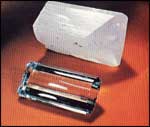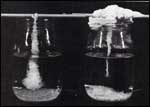Crystals
What do you think of when you hear the word crystal? Does it bring to mind visions of expensive glassware on an elegant table, a type of chandelier, or merely the clear covering over the face of your watch? To the ancient Greeks who created the word, krystallos meant “clear ice.” But in terms of nature, the word should mean something else to you. A crystal is one of the basic forms of nature. There are many different crystals with thousands of different shapes, but they all have smooth flat surfaces, sharp edges, and corners. Let’s explore the world of crystals around us.

The blue topaz (top), official Texas gemstone, is shown in its natural and cut forms. (The jewel is part of the Co. W. E. Barron collection willed to and on permanent display at the University of Texas at Austin.)
Salt is a crystal found in everyone’s home. Each salt crystal is cube-shaped with six smooth sides. Salt refineries dissolve rock salt and, through evaporation, regrow the pure and uniform salt crystals that find their way to your table. Perhaps you would like to experiment with salt and “grow” your own crystals. To do this, add a half-cup of salt to a quart jar of cold water. Stir until the salt is dissolved. Repeat this procedure until no more salt will dissolve in the water and the excess settles to the bottom of the jar. Let the mixture sit for half an hour. Then pour the salty water into a clean jar, being careful not to include the undissolved salt at the bottom.

The geode, a round concretion or nodule partly filled with crystals which grow inward from the walls into a hollow center, can contain beautiful amethyst crystals.
Now you are ready to grow your crystals. Tie a piece of string to the middle of a pencil. The string should be long enough to reach almost to the bottom of the jar. Lay the pencil across the top of the jar and let the string hang down in the middle of the salty water. Set the jar aside where it will not be disturbed. In a few weeks, salt crystals will begin to form on the string.
If you like faster action, another crystal you can grow in your home is alum. Alum can be purchased in powdered form at the drugstore. To grow this crystal, dissolve three ounces of powdered alum in fifteen ounces of warm water. The alum will completely disappear and the water will be clear. Suspend a string tied to a pencil in the alum solution as with the salt. In a few hours you will be able to see the crystals forming on the string. The alum crystal is also six-sided but looks like two pyramids joined at their bases.

Geodes can also contain delicate needlelike rutile crystals.
Another common crystal used in the home is sugar, but it does not appear naturally in crystal form. The sugar crystals on your table were man-made from sugarcane or sugar beets. Sugarcane stalks are crushed, and the juice is squeezed out. When the water is boiled out of the juice, brown sugar crystals form in the thick syrup. These crystals are bleached and purified to make sugar as we buy it. Rock candy is large crystals of sugar which candy manufacturers grow on strings suspended in large vats of pure sugar syrup.
Many crystals are found
in rocks. Granite is a
beautiful rock made up
of three different types
of crystals—white
or pink feldspar, quartz,
and black mica. If white
feldspar is present, the
granite is gray. If pink
feldspar is present, the
granite is pink or red.
Because of its crystal
content, granite can be
polished into a beautiful
building stone. The Texas
State Capitol Building
and surrounding state
office buildings are pink
granite.

All you need to grow alum or salt crystals is a jar, water, powdered alum or salt, some string, and a pencil.
Some crystals are valuable gem stones. Did you know that a diamond is a carbon crystal? Some diamonds form cubes and others double pyramids. The ones we see in jewelry are cut and polished and do not look like the natural crystals.
The diamond crystal is formed when carbon is put under pressure (a million pounds per square inch) and heated at the same time (over 2,500 degrees). These pressures and temperatures are found at least 150 miles deep I the earth. Sometimes when the earth’s surface shifts or water cuts dee4ply through rock, these valuable crystals are exposed or find their way to river beds where they can be picked up.
Rubies and sapphires are corundum crystals. Impurities in the clear corundum mineral cause the beautiful colors of these gem stones. If chromium is present, a ruby is formed. Traces of titanium and iron cause the sapphire color.

Don't be surprised when evaporation causes salt to form on the pencil long before these alum crystals grow on the string.
Many gem stones are formed from quartz crystals. Pure quartz forms the rock crystal and impurities again make the various colors. The amethyst is purple, and citrine is yellow. The rose quartz contains a trace of titanium, and there are also a blue quartz and a smoky quartz. A rare green quartz was produced by a gemologist who heated a purple quartz found in Brazil.
Not all quartz crystals are gem stones. Common grains of sand are usually quartz crystals. Although their corners and sharp edges are often worn off by wind and wave action, they are still crystals.
When electricity is applied to certain quartz crystals, they vibrate. These precise vibrations at carefully determined rates keep radio transmitters on proper broadcast frequencies. If the crystals are tuned to different frequencies, they can separate calls on a telephone channel. We could not have modern television without its crystal parts. Quartz also is used for lenses in telescopes and motion picture projectors. The fact that quartz does not crack or change size when heated or cooled makes it perfect for these uses.

Compare the pyramid shape of the alum crystals with the cube shape of these salt crystals. Notice how the basic shapes are repeated in each crystal.
The ruby crystal also is more than just an object of beauty. Ruby crystals can generate the powerful burst of light needed for the laser beam. These beams of intense light can destroy cancerous tissue or drill holes in diamonds.
Some crystals can convert light into electricity. The transistor we hear so much about is made from germanium or silicon crystals smaller than the letter o on this page. These tiny transistors have made possible the age of electronic miniaturization. Entire electronic circuits can be contained on a single speck of silicon crystal. Thin, purple-blue rectangles of silicon (solar cells) are used on spacecraft to convert sunlight into electricity at rates as high as ten watts per square foot of surface area.
Thus far, we have discussed crystals that last. Now let’s think of crystals that do not last—snowflakes. Snow crystals all have six sides, but the complexity of their formation depends upon the atmosphere. Simple crystals form in high, cold clouds where rapid freezing takes place. The lacy, more complex crystals are formed in low, warm clouds. The amazing thing about snow crystals is the fact that no two snowflakes are exactly alike. All are uniquely different.
So whether crystals improve the flavor of your food, add beauty to your life, or work for you in various ways, it is nice to have them all around us.
Ilo
Hiller
1983 Crystals. Young
Naturalist. The
Louise Lindsey Merrick Texas
Environment Series, No.
6, pp. 110-113. Texas A&M
University Press, College
Station.